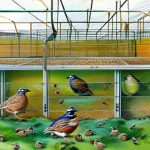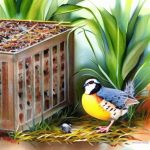Proper quail breeding pen size is crucial for the health and well-being of the quail, as well as for successful breeding. The size of the pen directly impacts the quail’s ability to exhibit natural behaviors, such as foraging, dust bathing, and mating. Inadequate space can lead to stress, aggression, and reduced fertility, while ample space allows for a more natural and comfortable environment, leading to healthier and more productive quail. Additionally, proper pen size is essential for maintaining good air quality and preventing the spread of diseases. Therefore, it is important for quail breeders to carefully consider and calculate the appropriate pen size for their breeding operations.
Proper quail breeding pen size is also important for the overall management and efficiency of the breeding operation. A well-designed and adequately sized pen allows for easier management of the quail, including feeding, watering, and monitoring their health. It also facilitates the collection of eggs and reduces the risk of egg breakage. Furthermore, a properly sized pen can help prevent overcrowding, which can lead to increased competition for resources and potential injuries. Overall, ensuring the proper size of quail breeding pens is essential for the health and productivity of the quail, as well as for the success of the breeding operation.
Table of Contents
- 1 Factors to Consider When Determining Quail Breeding Pen Size
- 2 Guidelines for Calculating Quail Breeding Pen Size
- 3 Benefits of Providing Adequate Space in Quail Breeding Pens
- 4 Common Mistakes to Avoid When Determining Quail Breeding Pen Size
- 5 Tips for Managing Quail Breeding Pens of Different Sizes
- 6 Ensuring Optimal Quail Breeding Pen Size for Successful Breeding
- 7 FAQs
- 7.1 What is the ideal size for a quail breeding pen?
- 7.2 What are the benefits of providing adequate space in a quail breeding pen?
- 7.3 What are the consequences of overcrowding in a quail breeding pen?
- 7.4 How can I calculate the size of a quail breeding pen for a specific number of birds?
- 7.5 Are there any specific requirements for the design of a quail breeding pen?
Key Takeaways
- Proper quail breeding pen size is crucial for the health and productivity of quail.
- Factors to consider when determining quail breeding pen size include the number of quail, their size, and their behavior.
- Guidelines for calculating quail breeding pen size involve providing at least 1 square foot of space per quail and considering the height of the pen.
- Providing adequate space in quail breeding pens can lead to reduced stress, improved egg production, and overall better quail health.
- Common mistakes to avoid when determining quail breeding pen size include overcrowding and underestimating the space needed for quail to thrive.
Factors to Consider When Determining Quail Breeding Pen Size
When determining the size of quail breeding pens, there are several factors that need to be taken into consideration. Firstly, the breed and age of the quail must be considered, as different breeds and age groups have varying space requirements. For example, larger breeds may require more space than smaller ones, and adult quail may need more space than chicks. Additionally, the sex ratio of the quail should be considered, as males may require more space to reduce aggression during mating.
Another important factor to consider is the purpose of the breeding operation. If the goal is to produce eggs for consumption, a larger pen size may be necessary to accommodate a higher number of laying hens. On the other hand, if the focus is on breeding quail for meat production, a smaller pen size may be sufficient for raising broilers. Furthermore, the available space and resources should be taken into account when determining pen size, as well as any future expansion plans for the breeding operation.
The climate and environmental conditions of the location also play a role in determining pen size. In hotter climates, larger pens with adequate shade and ventilation may be necessary to prevent heat stress, while in colder climates, smaller pens with proper insulation may be sufficient. Overall, when determining quail breeding pen size, it is important to consider the specific needs of the quail, the goals of the breeding operation, available resources, and environmental conditions.
Guidelines for Calculating Quail Breeding Pen Size
There are several guidelines that can be followed to calculate the appropriate size of quail breeding pens. One common recommendation is to provide at least 1 square foot of floor space per quail. However, this guideline may vary depending on the breed and age of the quail, as well as the purpose of the breeding operation. For example, laying hens may require 1.5 to 2 square feet of space per bird to accommodate nesting boxes and allow for comfortable egg laying.
Another guideline to consider is providing adequate space for natural behaviors such as foraging and dust bathing. Quail are ground-dwelling birds that require space to move around and engage in natural behaviors. Therefore, it is important to provide enough floor space to allow for these activities. Additionally, when calculating pen size, it is important to consider the height of the pen to ensure that there is enough headroom for the quail to stand and move comfortably.
Furthermore, when calculating pen size, it is important to take into account any additional structures or equipment that will be placed in the pen, such as feeders, waterers, nesting boxes, and perches. These structures will take up space and should be factored into the overall pen size calculations. Overall, following these guidelines can help ensure that quail breeding pens are appropriately sized to meet the needs of the quail and the goals of the breeding operation.
Benefits of Providing Adequate Space in Quail Breeding Pens
Providing adequate space in quail breeding pens offers a wide range of benefits for both the quail and the breeder. Firstly, ample space allows quail to exhibit natural behaviors such as foraging, dust bathing, and mating, which are essential for their physical and psychological well-being. This can lead to reduced stress levels, improved overall health, and increased fertility and egg production. Additionally, providing adequate space can help reduce aggression and injuries among quail by minimizing competition for resources.
Furthermore, proper pen size can contribute to better air quality within the pens by reducing ammonia levels and preventing respiratory issues. This is particularly important in enclosed or indoor breeding facilities where ventilation may be limited. Good air quality can help prevent the spread of diseases and improve overall quail health. Additionally, providing adequate space in breeding pens can make it easier for breeders to manage and monitor their quail, leading to more efficient operations and better overall productivity.
Moreover, ensuring that quail breeding pens are appropriately sized can contribute to a positive public perception of the breeding operation. Consumers are increasingly concerned about animal welfare and may prefer products from farms that prioritize animal well-being. By providing ample space for their quail, breeders can demonstrate their commitment to ethical and sustainable practices. Overall, providing adequate space in quail breeding pens offers numerous benefits for both the quail and the breeder, leading to healthier birds and a more successful breeding operation.
Common Mistakes to Avoid When Determining Quail Breeding Pen Size
When determining quail breeding pen size, there are several common mistakes that breeders should avoid to ensure the health and productivity of their quail. One common mistake is underestimating the space requirements of the quail based on general guidelines without considering specific breed and age requirements. Different breeds and age groups have varying space needs, so it is important to take these factors into account when calculating pen size.
Another common mistake is overcrowding pens in an attempt to maximize production without considering the negative impacts on quail health and well-being. Overcrowding can lead to increased stress levels, aggression, and competition for resources among quail. It can also contribute to poor air quality and an increased risk of disease transmission. Therefore, it is important to resist the temptation to overcrowd pens and instead prioritize providing adequate space for the quail.
Furthermore, breeders should avoid neglecting environmental factors such as climate and ventilation when determining pen size. Inadequate ventilation in smaller pens can lead to heat stress in hot climates or poor air quality in enclosed facilities. Similarly, failing to provide adequate shade or insulation can have negative impacts on quail health and productivity. Overall, by avoiding these common mistakes and carefully considering the specific needs of their quail, breeders can ensure that their breeding pens are appropriately sized for optimal results.
Tips for Managing Quail Breeding Pens of Different Sizes

Managing quail breeding pens of different sizes requires careful attention to the specific needs of the quail as well as operational considerations. For larger pens, it is important to establish clear feeding and watering areas to ensure that all quail have access to food and water. This may involve strategically placing multiple feeders and waterers throughout the pen to prevent overcrowding at one location. Additionally, larger pens may require more frequent cleaning and maintenance to ensure good hygiene and prevent disease spread.
In smaller pens, it is important to maximize space utilization by using vertical space for perches or nesting boxes. This can help provide additional room for natural behaviors while still accommodating a higher number of quail in a smaller area. Additionally, breeders should pay close attention to ventilation in smaller pens to prevent heat stress or poor air quality. Providing adequate shade or insulation may also be necessary depending on the climate.
Regardless of pen size, regular monitoring of quail behavior and health is essential for successful management. This includes observing feeding patterns, egg production, signs of aggression or stress, and overall flock dynamics. By staying attentive to these factors, breeders can make necessary adjustments to ensure that their quail are thriving in their respective pen sizes.
Ensuring Optimal Quail Breeding Pen Size for Successful Breeding
In conclusion, proper quail breeding pen size is essential for ensuring the health and productivity of quail as well as for successful breeding operations. When determining pen size, breeders must consider a variety of factors including breed and age requirements, purpose of the operation, available resources, environmental conditions, and specific needs of their quail. Following guidelines for calculating pen size can help ensure that quail have adequate space to exhibit natural behaviors while also allowing for efficient management of the breeding operation.
Providing adequate space in quail breeding pens offers numerous benefits including improved quail health and welfare, better air quality, increased productivity, and a positive public perception of ethical practices. However, breeders must avoid common mistakes such as underestimating space requirements or overcrowding pens in an attempt to maximize production. By carefully managing pens of different sizes and paying close attention to quail behavior and health, breeders can ensure that their operations are optimized for success. Overall, ensuring optimal quail breeding pen size is crucial for creating a healthy and sustainable environment for quail breeding.
Providing adequate space in quail breeding pens is essential for the overall well-being and success of the quail breeding operation. When pens are spacious, quails have room to move around freely, engage in natural behaviors, and establish social hierarchies without feeling crowded or stressed. This leads to healthier and happier quails, which in turn results in better egg production and overall productivity. Additionally, proper spacing allows for better air circulation, reducing the risk of respiratory issues and improving the overall air quality within the pens. Furthermore, maintaining appropriate pen sizes demonstrates a commitment to ethical and responsible breeding practices, which can enhance the public perception of the operation. Therefore, it is crucial for breeders to prioritize and carefully manage the space within their quail breeding pens to ensure the well-being and success of their quail breeding endeavors.
If you are considering building a quail breeding pen, you may also be interested in learning how to insulate a chicken coop to ensure the comfort and well-being of your birds. This article provides valuable information on the importance of insulating a coop and the different methods you can use to keep your chickens warm during the colder months. Proper insulation can also be beneficial for quail breeding pens, as it helps maintain a stable and comfortable environment for the birds.
FAQs
What is the ideal size for a quail breeding pen?
The ideal size for a quail breeding pen is 1 square foot per bird. This allows for enough space for the quails to move around comfortably and reduces the risk of aggression and stress.
What are the benefits of providing adequate space in a quail breeding pen?
Providing adequate space in a quail breeding pen helps to reduce stress and aggression among the birds. It also allows for better air circulation and reduces the risk of disease transmission.
What are the consequences of overcrowding in a quail breeding pen?
Overcrowding in a quail breeding pen can lead to increased stress, aggression, and cannibalism among the birds. It can also result in poor air quality and an increased risk of disease transmission.
How can I calculate the size of a quail breeding pen for a specific number of birds?
To calculate the size of a quail breeding pen for a specific number of birds, simply multiply the number of birds by 1 square foot. For example, if you have 20 quails, you will need a pen that is at least 20 square feet in size.
Are there any specific requirements for the design of a quail breeding pen?
Quail breeding pens should have solid walls to provide privacy and reduce stress among the birds. They should also have good ventilation and access to natural light. Additionally, the flooring should be easy to clean and provide good traction for the birds.
Meet Walter, the feathered-friend fanatic of Florida! Nestled in the sunshine state, Walter struts through life with his feathered companions, clucking his way to happiness. With a coop that’s fancier than a five-star hotel, he’s the Don Juan of the chicken world. When he’s not teaching his hens to do the cha-cha, you’ll find him in a heated debate with his prized rooster, Sir Clucks-a-Lot. Walter’s poultry passion is no yolk; he’s the sunny-side-up guy you never knew you needed in your flock of friends!







